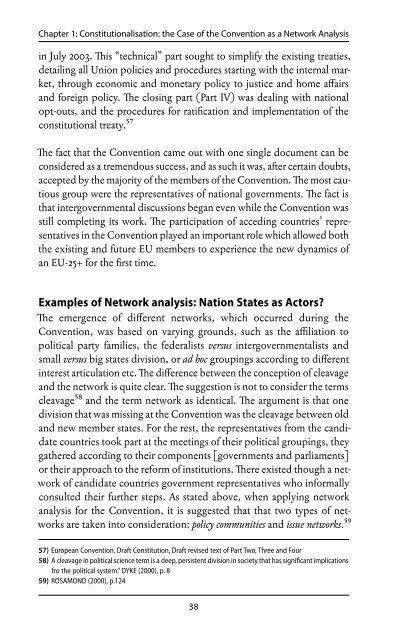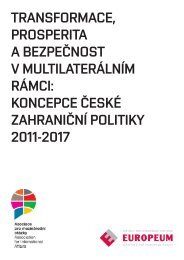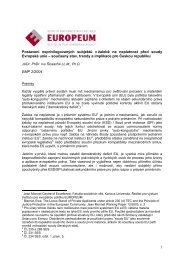eu constitutionalisation - EUROPEUM Institute for European Policy
eu constitutionalisation - EUROPEUM Institute for European Policy
eu constitutionalisation - EUROPEUM Institute for European Policy
You also want an ePaper? Increase the reach of your titles
YUMPU automatically turns print PDFs into web optimized ePapers that Google loves.
Chapter 1: Constitutionalisation: the Case of the Convention as a Network Analysisin July 2003. This “technical” part sought to simplify the existing treaties,detailing all Union policies and procedures starting with the internal market,through economic and monetary policy to justice and home affairsand <strong>for</strong>eign policy. The closing part (Part IV) was dealing with nationalopt-outs, and the procedures <strong>for</strong> ratification and implementation of theconstitutional treaty.⁵⁷The fact that the Convention came out with one single document can beconsidered as a tremendous success, and as such it was, after certain doubts,accepted by the majority of the members of the Convention. The most cautiousgroup were the representatives of national governments. The fact isthat intergovernmental discussions began even while the Convention wasstill completing its work. The participation of acceding countries’ representativesin the Convention played an important role which allowed boththe existing and future EU members to experience the new dynamics ofan EU-25+ <strong>for</strong> the first time.Examples of Network analysis: Nation States as Actors?The emergence of different networks, which occurred during theConvention, was based on varying grounds, such as the affiliation topolitical party families, the federalists versus intergovernmentalists andsmall versus big states division, or ad hoc groupings according to differentinterest articulation etc. The difference between the conception of cleavageand the network is quite clear. The suggestion is not to consider the termscleavage⁵⁸ and the term network as identical. The argument is that onedivision that was missing at the Convention was the cleavage between oldand new member states. For the rest, the representatives from the candidatecountries took part at the meetings of their political groupings, theygathered according to their components [governments and parliaments]or their approach to the re<strong>for</strong>m of institutions. There existed though a networkof candidate countries government representatives who in<strong>for</strong>mallyconsulted their further steps. As stated above, when applying networkanalysis <strong>for</strong> the Convention, it is suggested that that two types of networksare taken into consideration: policy communities and issue networks.⁵⁹57) <strong>European</strong> Convention, Draft Constitution, Draft revised text of Part Two, Three and Four58) A cleavage in political science term is a deep, persistent division in society that has significant implicationsfro the political system.” DYKE (2000), p. 859) ROSAMOND (2000), p.12438Chapter 1: Constitutionalisation: the Case of the Convention as a Network Analysis<strong>Policy</strong> communities are more organized and stable entities evolved inthe Convention, with regular interaction and patterns of communication,whose membership is derived from belonging to certain segmentsof the Convention: the Presidium, government representatives,national parliaments representatives and alternates, MEPs, membersof the Commission, representatives of the candidate countries, femalerepresentatives, and so on.⁶⁰Issue networks, on the other hand, were characterized by fluidity ofmembers who created different networks connected with different issuesand interests during the Convention. The membership in these groupingswas usually in flux. As an example of a stable ‘issue network’ can serve theFranco-German relationship, more fluidity can be found <strong>for</strong> instance inthe ‘like-minded countries group’ or in the cooperation between Polandand Spain on the QMV.The dynamics of the Convention were closely connected with level ofactivities of the traditional engine of the integration process, the Franco-German cooperation. Other groupings were <strong>for</strong>med mainly after thestrengthening of the French–German tandem, when their governmentdelegations were empowered by the presence of the ministers of <strong>for</strong>eignaffairs, Villepin and Fischer, in September 2002. Coordination amongthese two countries resulted into several proposals, the most importantof which dealt with the institutional re<strong>for</strong>m and was launched in January2003 at the 40tʰ anniversary of the signing of the Elysée Treaty. Thisproposal called <strong>for</strong> the creation of a permanent Chair of the <strong>European</strong>Council, a “double-hatted” Union Minister of Foreign Affairs, a smaller,and thus more efficient, Commission, with the EP involved in its appointment.A Congress of national parliamentarians would serve as a newsecond chamber of the <strong>European</strong> Parliament.⁶¹Fischer’s shifting positions during the beginning of 2003, after the agreementhad been reached between the Germans and the French was reached,are instructive. His willingness to listen, argue, persuade and explain facili-60) „<strong>Policy</strong> community is understood in all the literature in some sense as a common culture and understandingsabout the nature of the problems and decision-making processes within a given policy domain.”DOWDING (1995), p. 13861) <strong>European</strong> Convention, Contribution Franco-Allemande a la Convention Europeenne sur l‘Architectureinstitutionelle de l‘Union,39








